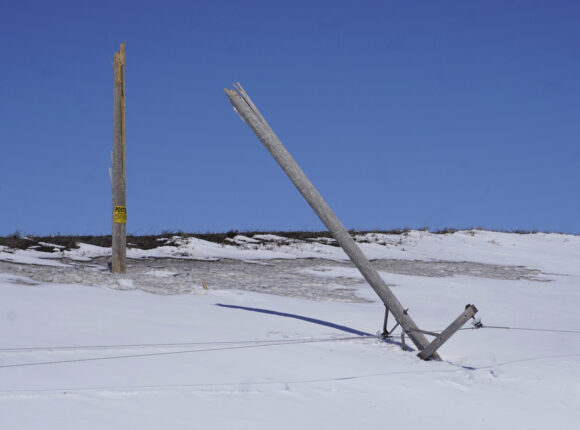BISMARCK, N.D. (AP) — A combination of ugly weather has left at least 19,000 people in western North Dakota facing days without power and thousands of residents along the Red River that separates that state from Minnesota dealing with flash flooding.
A blizzard over the weekend that included a mixture of snow, rain, ice and strong winds snapped hundreds or thousands of power poles in the western part of the state, leaving damage that a spokesman for a 100-year-old utility company called the worst ever in its system.
At the same time, Minnesota sent National Guard members to help sandbag in Crookston, about 30 miles (48 kilometers) from the North Dakota border, due to heavy rains. The National Weather Service originally warned of a record crest on the Red Lake River but the river peaked Monday at about 27 feet. The record high water mark was 28.4 feet in 1997.
North Dakota Emergency Services spokesman Eric Jensen estimated that more than 19,000 people were without power “and it could be even more that,” noting that tracking the outages is a complicated process.
Mark Hanson, spokesman for Bismarck-based Montana-Dakota Utilities, said the northwestern communities of Grenora, Zahl, Crosby, Powers Lake, McGregor and Wildrose likely will not have power restored until the end of the week. Ambrose could be out for up to two weeks.
“The damage we have assessed so far is unprecedented,” Hanson said. “We have hundreds of crossarms broken and miles of poles down.”
Montana-Dakota Utilities will have at least 15 crews in northwestern North Dakota this week, possibly more if aerial surveys Monday show even more damage than anticipated, The Bismarck Tribune reported.
The blizzard dropped as much as 11/2 feet of snow on western North Dakota and also brought widespread freezing rain that coated trees and power lines. Wind gusts up to 50 mph were recorded in several places.
In the Red River Valley, volunteers and National Guard members spent two days sandbagging to fortify the city of Crookston. About 50 of the 100 National Guard members authorized by Minnesota Gov. Tim Walz assisted with the flood fight. There were no reports of damage or injuries.
The Red Lake River flows into the Red River at East Grand Forks and Grand Forks, North Dakota, where officials from the two cities have started to activate some of their permanent flood protection measures put into place after a 1997 flood that devastated the two cities.
Forecasters expect a crest of 48 feet (14.63 meters) later this week on the Red River in Grand Forks, but the cities have protection to 57 feet (17.37 meters) and more. Built-in floodwalls were being activated on both sides of the river. Officials on Monday planned to close one of the bridges that connects the two cities.
The southeastern North Dakota town of Valley City, which sits along another Red River tributary, has been sandbagging to protect against the rising Sheyenne River. Fargo officials donated 29,000 sandbags to help.
Valley City Mayor Dave Carlsrud said the community pride was evident in the number of people, including students from Valley City State University, who volunteered.
“People are just, that’s why I like living in North Dakota. Last week, when it was blowing snow in my face, I wasn’t too sure. But today, I am again,” Carlsrud said.
About the photo: One of several Verendrye Electric Cooperative poles on a line along a Ward County road south of Minot, N.D., snapped in two on Monday, April 25, 2022, after a weekend storm due to heavy ice on the power lines. Weather problems have left at least 19,000 people in western North Dakota facing days without power and thousands of residents along the Red River that separates that state from Minnesota dealing with flash flooding. (Jill Schramm/Minot Daily News via AP)
Was this article valuable?
Here are more articles you may enjoy.


 Tesla Drivers Are Buying Escape Tools and Cars to Avoid Getting Trapped Inside
Tesla Drivers Are Buying Escape Tools and Cars to Avoid Getting Trapped Inside  Rare Weather Warning Issued as Strong Gusts Fuel Colorado Wildfire Threats
Rare Weather Warning Issued as Strong Gusts Fuel Colorado Wildfire Threats  NYT Asks Judge to Dismiss Trump’s ‘Implausible’ Defamation Suit
NYT Asks Judge to Dismiss Trump’s ‘Implausible’ Defamation Suit  Cat Bonds Linked to Wildfires Lose ‘Once Untouchable’ Status
Cat Bonds Linked to Wildfires Lose ‘Once Untouchable’ Status 